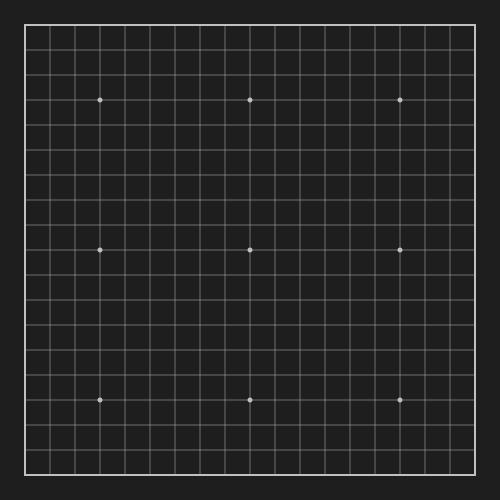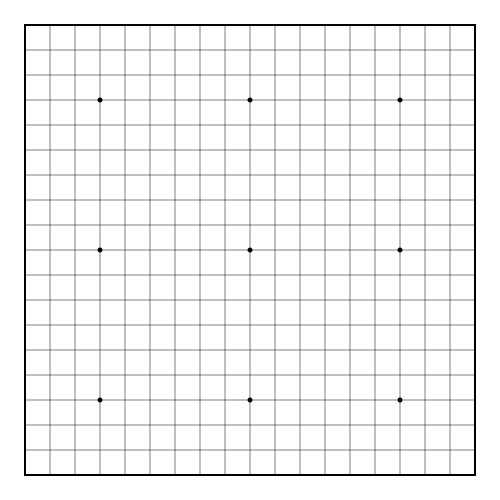Go


Usage
or you can directly load Go class
Description
Go is an abstract strategy board game for two players in which the aim is to surround more territory than the opponent. The game was invented in China more than 2,500 years ago and is believed to be the oldest board game continuously played to the present day.
Rules
The rule implemented in Pgx follows Tromp-Taylor Rules.
Note
By default, we use 7.5. Users can set different komi at Go class constructor.
Note
The Tromp-Taylor rule enforces PSK (Positional Superko). However, strictly implementing PSK to determine legal moves is inefficient, as it requires computing the hash for all possible subsequent board states. Since PSK rarely occurs—based on our best knowledge—most implementations compromise. For example:
OpenSpiel uses SSK (Situational Superko) instead of PSK to compute legal moves, and if a PSK move occurs, the game ends in a tie. PettingZoo also uses SSK for legal moves but ignores PSK moves altogether. The strict rule is: "PSK for legal moves, and any PSK move results in an immediate loss." Like others, we also compromise. Our approach is similar to OpenSpiel:
Pgx uses SSK for legal moves, but any PSK move results in an immediate loss. Overall, we believe the impact of this compromise is minimal, especially on a 19x19 board, since PSK scenarios are rare.
| Tromp-Taylor | OpenSpiel | PettingZoo | Pgx | |
|---|---|---|---|---|
| legal action | PSK | SSK | SSK | SSK |
| PSK occurrence | loss | tie | ignore (SSK) | loss |
Specs
Let N be the board size (e.g., 19).
| Name | Value |
|---|---|
| Version | v1 |
| Number of players | 2 |
| Number of actions | N x N + 1 |
| Observation shape | (N, N, 17) |
| Observation type | bool |
| Rewards | {-1, 1} |
Observation
We follow the observation design of AlphaGo Zero [Silver+17].
| Index | Description |
|---|---|
obs[:, :, 0] |
stones of player_id (@ current board) |
obs[:, :, 1] |
stones of player_id's opponent (@ current board) |
obs[:, :, 2] |
stones of player_id (@ 1-step before) |
obs[:, :, 3] |
stones of player_id's opponent (@ 1-step before) |
| ... | ... |
obs[:, :, -1] |
color of player_id |
Note
For the final dimension, there are two possible options:
- Use the color of current player to play
- Use the color of
player_id
This ambiguity happens because observe function is available even if player_id is different from state.current_player.
In AlphaGo Zero paper [Silver+17], the final dimension C is explained as:
The final feature plane, C, represents the colour to play, and has a constant value of either 1 if black is to play or 0 if white is to play.
however, it also describes as
the colour feature C is necessary because the komi is not observable.
So, we use player_id's color to let the agent know komi information.
As long as it's called when player_id == state.current_player, this doesn't matter.
Action
Each action ({0, ..., N * N - 1}) represents the point to be colored.
The final action represents pass action.
Rewards
Non-zero rewards are given only at the terminal states. The reward at terminal state is described in this table:
| Reward | |
|---|---|
| Win | +1 |
| Lose | -1 |
Termination
Termination happens when
- either one plays two consecutive passes, or
N * N * 2steps are elapsed[Silver+17].
Version History
v1: Superko rule change in #1224 (v2.4.0)v0: Initial release (v1.0.0)
Reference
[Silver+17]"Mastering the game of go without human knowledge" Nature
Baseline models
Pgx offers a baseline model for Go (9x9). Users can use it for an anchor opponent in evaluation. See our paper for more details. See this colab for how to use it.
| Model ID | Description |
|---|---|
go_9x9_v0 |
See our paper for the training details. |